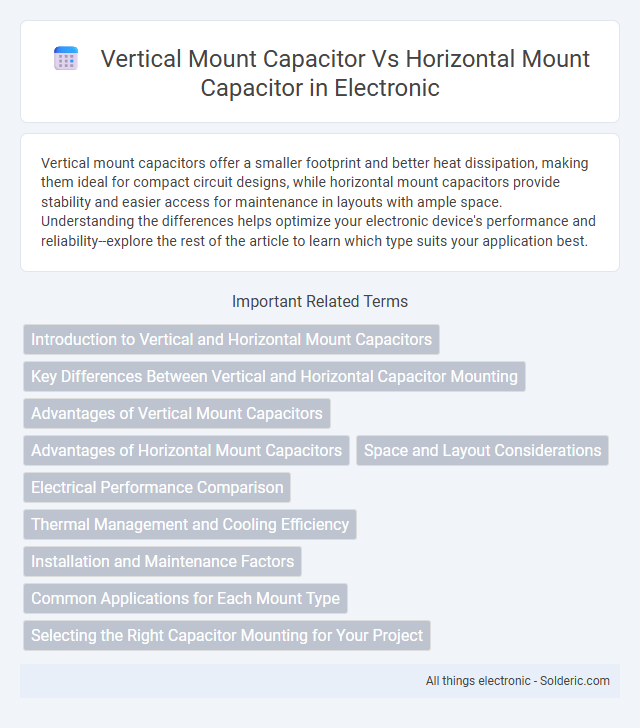Vertical mount capacitors offer a smaller footprint and better heat dissipation, making them ideal for compact circuit designs, while horizontal mount capacitors provide stability and easier access for maintenance in layouts with ample space. Understanding the differences helps optimize your electronic device's performance and reliability--explore the rest of the article to learn which type suits your application best.
Comparison Table
| Feature | Vertical Mount Capacitor | Horizontal Mount Capacitor |
|---|---|---|
| Mounting Orientation | Mounted upright, leads at the base | Mounted flat, leads extend horizontally |
| Space Efficiency | Requires less PCB footprint area | Requires more PCB footprint area |
| Cooling | Better heat dissipation due to vertical airflow | Lower heat dissipation, prone to heat accumulation |
| Mechanical Stability | Less stable under vibration but easier to replace | More stable under vibration and mechanical stress |
| Application | Used in compact or vertically constrained designs | Used in low-height, stable mounting scenarios |
| Cost | Slightly higher due to packaging | Generally lower cost and simpler design |
Introduction to Vertical and Horizontal Mount Capacitors
Vertical mount capacitors are designed with leads extending from the bottom, allowing them to stand upright on circuit boards, which optimizes space in compact electronic assemblies. Horizontal mount capacitors lie flat with leads protruding from either side, offering stability and better heat dissipation in designs where vertical height is limited. The choice between vertical and horizontal mount capacitors impacts the overall layout, thermal management, and mechanical stability of electronic devices.
Key Differences Between Vertical and Horizontal Capacitor Mounting
Vertical mount capacitors feature a compact footprint suited for high-density circuit boards, while horizontal mount capacitors offer greater mechanical stability due to their flat orientation. Vertical capacitors typically enable easier heat dissipation and faster installation, whereas horizontal capacitors provide enhanced shock resistance and are preferred in applications requiring robust physical protection. Differences in lead configuration and mounting angles impact solder joint reliability and electromagnetic interference performance in various electronic devices.
Advantages of Vertical Mount Capacitors
Vertical mount capacitors offer superior space efficiency by occupying less board surface area, enabling higher component density in compact electronic designs. Their configuration allows for better heat dissipation and improved airflow, which enhances reliability and lifespan. Additionally, vertical mounting facilitates easier automated placement during PCB assembly, reducing manufacturing time and costs.
Advantages of Horizontal Mount Capacitors
Horizontal mount capacitors offer improved heat dissipation due to their larger surface area in contact with the mounting surface, enhancing thermal management and prolonging component lifespan. Their compact design facilitates easier installation in confined spaces, making them ideal for applications with limited vertical clearance. Additionally, horizontal mounts provide better mechanical stability, reducing the risk of vibration damage in automotive and industrial environments.
Space and Layout Considerations
Vertical mount capacitors save valuable PCB space by occupying less surface area, making them ideal for compact and densely populated boards. Horizontal mount capacitors provide a lower profile, which can be beneficial in designs with height restrictions or when stacking components. Your choice between vertical and horizontal mount capacitors should balance available board space with device height requirements to optimize overall layout efficiency.
Electrical Performance Comparison
Vertical mount capacitors generally offer better electrical performance due to improved heat dissipation and lower equivalent series resistance (ESR), which enhances their frequency response and reduces energy losses. Horizontal mount capacitors may exhibit higher ESR and inductance, leading to decreased efficiency in high-frequency applications and potential thermal management challenges. Selection depends on circuit design requirements, with vertical mounting preferred in high-power or high-frequency settings for optimal electrical characteristics.
Thermal Management and Cooling Efficiency
Vertical mount capacitors typically offer improved thermal management due to better airflow around the component, allowing heat to dissipate more efficiently compared to horizontal mount capacitors. The vertical orientation reduces the surface area in contact with the circuit board, minimizing heat buildup and enhancing cooling efficiency. This configuration is especially beneficial in high-power applications where maintaining optimal capacitor temperature extends lifespan and reliability.
Installation and Maintenance Factors
Vertical mount capacitors offer easier installation in tight spaces due to their compact footprint, making them ideal for equipment with limited horizontal clearance. Horizontal mount capacitors provide better heat dissipation and stability, simplifying maintenance by allowing easier access to terminals and visual inspection. Your choice depends on the available space and ease of periodic maintenance, especially in environments requiring quick capacitor replacements.
Common Applications for Each Mount Type
Vertical mount capacitors are commonly used in applications with limited board space, such as power supplies and compact electronics, where efficient heat dissipation and easy access for maintenance are essential. Horizontal mount capacitors find frequent application in circuit designs requiring low profile components, including audio equipment and automotive electronics, providing stability and reduced mechanical stress during operation. Your choice between vertical and horizontal mount capacitors depends on the specific spatial and thermal management requirements of your electronic project.
Selecting the Right Capacitor Mounting for Your Project
Selecting the right capacitor mounting for your project depends on space constraints, thermal management, and electrical performance. Vertical mount capacitors save PCB space and improve cooling efficiency by allowing airflow around the body, while horizontal mount capacitors offer mechanical stability and better alignment with certain circuit layouts. Evaluating these factors ensures optimal reliability and functionality in electronic designs.
vertical mount capacitor vs horizontal mount capacitor Infographic

 solderic.com
solderic.com